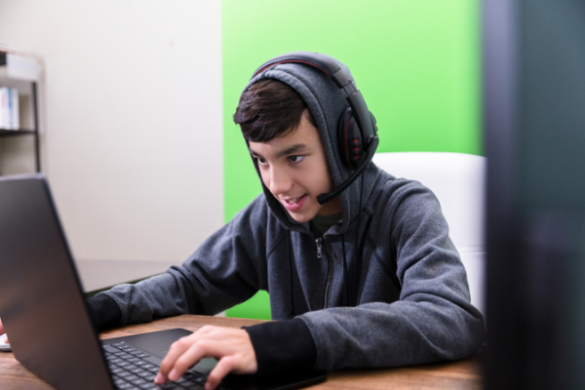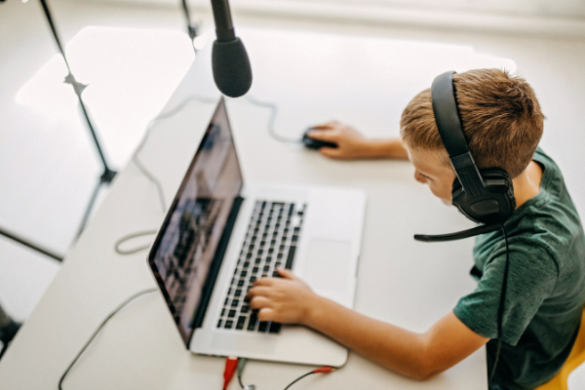When my seven-year-old approached me and asked if he could be a “Youtuber”, my first thought was “Is that even a real word?” When I was his age it certainly wasn’t. The platform didn’t even exist.
Now, as it turns out, major dictionaries like Oxford and Cambridge do include the word “Youtuber” and define it as “a person who uploads, produces, or appears in videos on the video-sharing website YouTube.”
As our children approach an age where they want to start engaging with open online platforms, navigating the risks of them sharing content with the world and putting themselves in the public eye can feel like an absolute minefield.
For most people over the age of thirty, who are not Youtubers themselves, this is an area outside our comfort zone. So when our children ask us whether they can take part in something that we ourselves have not taken part in, our natural instinct is to resist. Better safe than sorry, right?
I still think erring on the side of caution is a great approach, however, if your child is 17 and not 7, you might have a harder time making a decision like this one.
To help you make an informed decision, here are the things you should know and weigh up before letting your child start their own Youtube channel, or become a “Youtuber.”

What to know before your child starts a Youtube Channel
Learn the legal requirements and responsibilities
The Youtube age requirements for users vary from country to country. The most recent Australian Youtube Terms of Service Agreement dictate that “You must be at least 13 years old to use the Service; however, children of all ages may use the Service and YouTube Kids (where available) if enabled by a parent or legal guardian. If you are considered a minor in your country, you represent that you have your parent or guardian’s permission to use the Service.”
To put it simply, if you’re under 18, you require permission from an adult charged with your care.
The agreement also states that parents/guardians are “responsible for your child’s activity on the Service.”
This means you’ll be required to:
- Read and understand Youtube’s policies and community guidelines.
- Read the Youtube Terms of Service Agreement to your child and try to explain it in terms they will comprehend.
- Monitor the content your child creates and ensure it is all legal to publish and doesn’t infringe on anybody’s privacy or copyrights.
- Watch your child’s content before it is uploaded to ensure it follows Youtube’s policies and guidelines.
- Assist younger kids with the upload of videos.
Understand the risks
I’m still haunted by the frightening ideas explored in this 2018 TED talk on The nightmare videos of children’s YouTube, which strongly illustrates potential risks and dangers of letting your child have access to Youtube.
Such dangers include exposing your children to unsafe, cruel or criminal behaviours that they may copy, violence, sexualised content, fake news, commercial content, bullying, and prejudice of all kinds. And though I’ve summed it up in one sentence, this is A LOT of risk.
Youtube’s Child Safety Policy aims to protect children from such content and they have made some improvements to their platform over the past few years to enable a safer, more age-appropriate experience for kids. Their people and systems, however, are not foolproof. With 500 hours worth of video being uploaded every minute (source: Omnicoreagency), you can bet there are things being missed. As an example, only a few weeks ago, it was found that Youtube AI mistakenly inserted profanities into video captions.
These are just the risks of letting your kids watch Youtube. Letting children have their own channel poses even greater risks. Youtube has a well-documented Pedaphile problem and every parent should hold concerns for the privacy of any child publishing content online when it is viewable by the public.
Studies have also linked negative experiences with social media (eg. cyberbullying, harassment, dissatisfaction with number of likes etc) with an increase in screen time, depression, anxiety, low self-steem and poor self-image in young people. Not to mention the fact that most children do not understand the idea that once something is on the internet it’s kind of forever, or the notion that their future selves may cringe at the “cool” content they create now!
Are there any benefits?
Plenty! Youtube channels can provide creative outlets for kids where they can set goals, challenge and express themselves. They can use their channel to explore their own identity, to learn about new subjects and share that information.
Creating new videos also helps kids grow skills in content creation such as acting, commentating and editing.
The safest way to get started
Link your accounts
If you’ve weighed up the risks and benefits and accept the responsibilities of allowing your child to have a Youtube account and channel, they’re required to have a Google Account to use the service.
The safest way to get started is by creating your child’s Google account and linking it to your own, where you will have the ability to apply age-appropriate content setting and restrictions.
Youtube offers multiple supervised experiences for kids of different ages groups:
- Explore: Suitable for 9+.
- Explore More: For Kids 13+, this includes live streams.
- Most of YouTube: All content excluding age-restricted content.
You can learn how to create a Google account for your child, connect it to your account and program their settings here.
Choose your channel mode
Within your Youtube channel, you can set videos to public, private or unlisted. In a nutshell, public videos can be seen by anyone on Youtube and shared on the internet without restriction. Private videos will only be shared with who you choose, by adding the recipients’ email addresses, and cannot be found by search or commented on. Unlisted videos are essentially public but will not be shown on your feed or to subscribers.
Turn off comments
Don’t tempt the trolls. Disable comments on all videos, which protects your child from negative comments, cyberbullying, phishers, scammers and other unwanted interactions.
If your child is resistant to the idea of limiting the privacy and comments on their posts, then they may well be searching for fame and validation rather than a creative outlet. Talk openly with them about the importance of privacy and how fame limits privacy before deciding whether a Youtube channel is appropriate for your child.
Stay in the loop
From the outset, you should ensure your child understands what your role in their channel will be. If your child is under 13, then you’ll be responsible for managing every aspect of their channel, however even if you have a teenager, you should remain heavily involved in the planning and execution of their video content, and supervise who they are sharing it with.

Ultimately, as a parent, you’re charged with deciding what your child is ready for. Consider carefully whether you have the available time and energy to adequately support and supervise them and keep them safe before you grant them permission to create a Youtube channel.
On a related note, you may like to check out Mums of the Shire’s tips for keeping kids safe online or Google’s safety resources before proceeding further.

